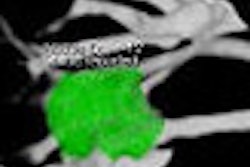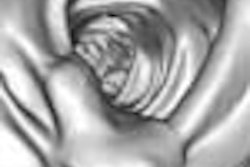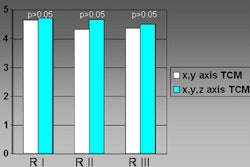Among the CT signs associated with perforated appendicitis and increased hospital stay, extraluminal air and moderate or severe periappendiceal inflammatory stranding are the most statistically significant independent predictors, according to research from the Mayo Clinic College of Medicine in Rochester, MN.
A focal defect in the enhancing appendiceal wall was also significantly associated with perforation, but had less specificity than extraluminal air, the researchers reported in Radiology (April 2005, Vol. 235:1, pp. 89-96).
In all, six CT signs were found to be statistically significant for perforation: extraluminal air, moderate or marked inflammatory stranding, focal enhancement defect, presence of periappendiceal fluid collections, presence of appendicolith, and cecal inflammation.
The study involved 86 patients who presented to the emergency department with abdominal pain and underwent appendectomy within 24 hours after CT.
The CT exams were performed using LightSpeed QXi or LightSpeed Plus multidetector-row CT scanners (GE Healthcare, Chalfont St. Giles, U.K.) with 5-mm reconstruction thickness at 5-mm intervals through the abdomen and pelvis in 85 patients. And for one patient, a HiSpeed single-section helical CT scanner was used, with 7-mm reconstruction thickness at 7-mm intervals.
The CT images were independently reviewed by two radiologists, and consensus interpretation was performed with a third radiologist.
CT findings specific to perforated appendicitis were observed in 13 patients. At surgery, 21 were confirmed with perforated appendicitis.
The difference in the mean diameter of normal and nonperforated appendices and perforated appendices was statistically significant but not clinically helpful, the research group noted. The location of the appendix, presence of mesenteric adenopathy, relative appendiceal enhancement, and the presence of small-bowel dilatation were not statistically significant.
Increased hospital stay
The individual CT findings that had significant association with increased hospital stay for patients in the entire cohort were extraluminal air, periappendiceal inflammation, focal defect in the appendiceal wall, presence of abscess, and periappendiceal and mesenteric fluid collections.
In patients without appendiceal perforation, there was a significant association between extraluminal air, periappendiceal inflammation, and focal defect in the enhancing appendiceal wall and increased hospital stay.
"In patients without appendiceal perforation, the association suggests either that CT signs of inflammation have greater relative importance as indicators of increased hospital stay, or that the presence of small perforations went undetected during surgical or pathologic examination in a subset of patients with significant findings of periappendiceal inflammation," the researchers wrote.
The group warned of misinterpretation of partial volume averaging as a focal enhancement defect in the appendiceal wall, especially in instances where the appendix was parallel or oblique to the scanning plane.
"There was less consistent agreement between the blinded observers for differentiation between periappendiceal fluid and abscess and for identification of a focal defect in the appendiceal wall," the researchers stated.
There was also poor interobserver agreement for specifying the degree of relative appendiceal enhancement. Increased relative appendiceal enhancement was subjective depending on the bowel segment used as the reference standard, according to the authors. This finding was not significantly associated with perforation.
Sensitivity and specificity
Overall, CT diagnosis for appendicitis had a sensitivity of 92%. However, CT signs for appendiceal perforation showed only moderate sensitivity. "The identification of an abscess or extraluminal air is a specific but insensitive finding in patients with perforated appendicitis," the group stated.
On the other hand, moderate or marked periappendiceal inflammatory changes in the mesoappendix and adjacent retroperitoneal fat and a focal defect in the enhancing appendiceal wall were more sensitive but less specific signs.
The study validated the use of several signs specific for appendiceal perforation that have been reported in other studies, the authors reported.
By N. Shivapriya
AuntMinnie.com staff writer
April 29, 2005
Related Reading
Presurgical imaging for appendicitis needed for young women, but not men, November 29, 2004
CT can be used to rule out appendicitis, October 11, 2004
Standard-dose no better than low-dose CT for diagnosing appendicitis, July 28, 2004
Copyright © 2005 AuntMinnie.com



















